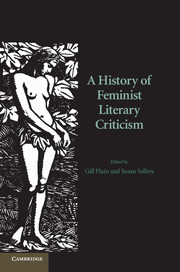Book contents
- Frontmatter
- Contents
- Acknowledgements
- Notes on contributors
- Introduction
- PART I PIONEERS AND PROTOFEMINISM
- PART II CREATING A FEMINIST LITERARY CRITICISM
- PART III POSTSTRUCTURALISM AND BEYOND
- Introduction to Part III
- 12 Feminist criticism and poststructuralism
- 13 Feminist criticism and psychoanalysis
- 14 French feminist criticism and writing the body
- 15 Postcolonial feminist criticism
- 16 Feminist criticism and queer theory
- 17 Feminist criticism and technologies of the body
- Postscript: flaming feminism?
- Index
- References
16 - Feminist criticism and queer theory
Published online by Cambridge University Press: 05 June 2012
- Frontmatter
- Contents
- Acknowledgements
- Notes on contributors
- Introduction
- PART I PIONEERS AND PROTOFEMINISM
- PART II CREATING A FEMINIST LITERARY CRITICISM
- PART III POSTSTRUCTURALISM AND BEYOND
- Introduction to Part III
- 12 Feminist criticism and poststructuralism
- 13 Feminist criticism and psychoanalysis
- 14 French feminist criticism and writing the body
- 15 Postcolonial feminist criticism
- 16 Feminist criticism and queer theory
- 17 Feminist criticism and technologies of the body
- Postscript: flaming feminism?
- Index
- References
Summary
In the late 1990s, several critics took the opportunity to reflect on the relations between feminism, lesbian studies and queer theory. A spate of articles and edited volumes discussed the conflicts and tensions between these fields: some, like the special issue of the feminist journal differences (1994) entitled ‘Feminism Meets Queer Theory’, were sanguine about the possibilities of rapprochement; others such as Cross-Purposes: Lesbians, Feminists, and the Limits of Alliance (Heller, 1997) emphasised conflict. It had been a strange couple of decades, marked by the unimaginable gains and tremendous losses of revolution. Stonewall, Women's Liberation, lesbian separatism, the porn wars, HIV/AIDS, the ‘invention’ of queer theory, lesbian chic, the emergence of transgender politics – all these events had radically transformed the texture of daily life, creating some unlikely coalitions and forever destroying others. While the pace of change had not slowed much, the scene had shifted significantly. Now, the conflicts that had ripped through these communities were being played out largely in academic venues. The fields of women's studies, gay and lesbian studies and queer studies had established themselves in academic departments to a degree that few had dreamed possible during the grittier and more explosive early years of second-wave feminism and Gay Liberation. Although critics were as divided as ever over longstanding questions about the politics of identity, the uses of theory and the relationship between gender and sexuality, one question cut across these differences: ‘What happened?
- Type
- Chapter
- Information
- A History of Feminist Literary Criticism , pp. 301 - 321Publisher: Cambridge University PressPrint publication year: 2007
References
- 12
- Cited by

